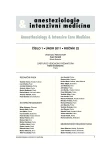Classification and diagnosis of kidney injury – are they still imperfect?
Authors:
Gerlichová Monika 1; Živný Pavel 2; Matějovič Martin 3; Černý Vladimír 1
Authors‘ workplace:
Klinika anesteziologie, resuscitace a intenzivní medicíny, Univerzita Karlova v Praze, LF v Hradci Králové a Fakultní nemocnice Hradec Králové
1; Ústav klinické biochemie a diagnostiky, Univerzita Karlova v Praze, LF v Hradci Králové a Fakultní nemocnice Hradec Králové
2; I. interní klinika – JIP, Univerzita Karlova v Praze, LF v Plzni, Fakultní nemocnice Plzeň
3
Published in:
Anest. intenziv. Med., 22, 2011, č. 1, s. 19-22
Category:
Intensive Care Medicine - Review Article
Overview
Much is known about the causes and pathophysiology of kidney injury however many questions concerning its prevention, treatment and, above all, early diagnosis are yet to be answered. Several studies have shown that even small increases in serum creatinine levels have crucial effects on the course of the disease and prognosis in various patient populations. For this reason it is important to search for new preventive and early therapeutic measures which would protect the organism from the negative impact of renal dysfunction. Early diagnosis of acute kidney injury is crucial. For this reason research is currently focused on the detection of early markers in the plasma and urine which would indicate renal injury within hours. Untill the reliability of these markers is tested, the monitoring of diuresis, serum creatinine levels or the calculation of the glomerular filtration rate remain the standard procedures. In order to differentiate pre-renal injury from acute tubular necrosis, the importance of the urinary sediment examination is increasing. New RIFLE and AKIN classifications have made the definition of acute kidney injury more precise. They have also unified the previous classification schemes and made it possible to compare the results of different studies in a better way.
Keywords:
acute kidney injury (AKI) – serum creatinine – glomerular filtration rate (GFR) –RIFLE and AKIN classification – early markers of renal dysfunction
Sources
1. Metnitz, P. G., Krenn, C. G., Steltzer, H. et al. Effect of acute renal failure requiring renal replacement therapy on outcome in critically ill patients. Crit. Care. Med., 2002, 30, 9, p. 2051–2058.
2. Druml, W. Acute renal failure is not a „cute“ renal failure! Intensive Care Med., 2004, 30, p.1886–1890.
3. Antunes, P. E., Prieto, D., Ferrao de Oliveira, J., Antunes, M. J. Renal dysfunction after myocardial revascularization. Eur. J. Cardiothorac. Surg., 2004, 25, 4, p. 597–604.
4. O`Brien, M. M., Gonzales, R., Shroyer, A. L. et al. Modest serum creatinine elevation affects adverse outcome after general surgery. Kidney Int., 2002, 62, 2, p. 585–592.
5. Fácila, L., Nunez, J., Bodí, V. et al. Prognostic value of serum creatinine in non-ST-elevation acute coronary syndrome. Rev. Esp. Cardiol., 2006, 59, 3, p. 209–216.
6. Kini, A. S., Sarkar, K., Rafael, O. C. et al. Serum creatinine ratio: a novel predictor of mortality after percutaneous coronary intervention in patient with normal and abnormal renal function. Catheter Cardiovascular Interv., 2009, 74, 1, p. 49–55.
7. Bellomo, R., Ronco, C., Kellum, J. A. et al. Acute renal failure - definition, outcome measures, animal models, fluid therapy and information technology needs: the Second International Consensus Conference of the Acute Dialysis Quality Initiative (ADQI) Group. Crit. Care, 2004, 8. Dostupný na www: http://ccforum.com/content/8/4/R204.
8. Mehta, R. L., Kellum, J. A., Shah, S. V. et al. Acute Kidney Injury Network: report of an initiative to improve outcomes in acute kidney injury. Crit. Care, 2007, 11. Dostupný na www: http://ccforum.com/content/11/2/R31.
9. Kidney Disease Outcome Quality Initiative. K/DOQI clinical practice guidelines for chronic kidney disease: evaluation, classification, and stratification. Am. J. Kidney Dis., 2002, 39, p.1–246.
10. Coca, S. G., Yalavarthy, R., Concato, J., Parikh, C. R. Biomarkers for the diagnosis and risk stratification of acute kidney injury: A systemic review. Kidney Int., 2008, 73, p. 1008–1016.
11. Klahr, S. The Modification of Diet in Renal Disease study. N. Engl. J. Med., 1989, 320, p. 864–866.
12. Zíma, T., Teplan, V., Tesař., V. et al. Doporučení České nefrologické společnosti a České společnosti klinické biochemie ČLS JEP k vyšetřování glomerulární filtrace. Aktuality v nefrologii, 2009, 3, p. 129–139.
13. Carvounis, C. P., Nisar, S., Guro-Razuman, S. Significance of the fractional excretions of urea in the differential diagnosis of acute renal failure. Kidney Int., 2002, 62, 6, p. 2223–2229.
14. Fahimi, D., Mohajeri, S., Hajizadeh, N. et al. Comparison between fractional excretions of urea and sodium in children with acute kidney injury. Pediatr. Nephrol., 2009, 24, 12, p. 2409–2412.
15. Steinhauslin, F., Burnier, M., Magnin, J. L. et al. Fractional excretion of trace lithium and uric acid in acute renal failure. J. Am. Soc. Nephrol., 1994, 4, 7, p. 1429–1437.
16. Perazella, M. A., Coca, S. G., Kanbay M. et al. Diagnostic Value of Urine Microscopy for Differential Diagnosis of Acute Kidney Injury in Hospitalized Patients. Clin. J. Am. Soc. Nephrol., 2008, 3, 6, p. 1615–1619.
17. Waikar, S. S., Bonventre J. V. Biomarkers for the diagnosis of acute kidney injury. Current Opinion in Nephrology and Hypertension, 2007, 16, p. 557–564.
18. Nguyen, M. T., Devarajan, P. Biomarkers for the early detection of acute kidney injury. Pediatr. Nephrol., 2008, 23, p. 2151–2157.
Labels
Anaesthesiology, Resuscitation and Inten Intensive Care MedicineArticle was published in
Anaesthesiology and Intensive Care Medicine

2011 Issue 1
Most read in this issue
- Classification and diagnosis of kidney injury – are they still imperfect?
- The administration of packed red blood cells and its influence on electrolyte and acid-base balance disturbances in vivo
- Evolution of Anaesthesiology and Resuscitation at Prague’s Medical Faculties
- New biomarkers in the diagnosis of renal dysfunction
